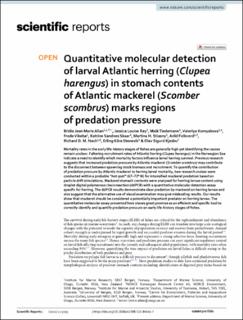Quantitative molecular detection of larval Atlantic herring (Clupea harengus) in stomach contents of Atlantic mackerel (Scomber scombrus) marks regions of predation pressure
Allen, Bridie; Ray, Jessica Louise; Tiedemann, Maik; Komyakova, Valeriya; Vikebø, Frode Bendiksen; Skaar, Katrine Sandnes; Stiasny, Martina H.; Folkvord, Arild; Nash, Richard David Marriott; Stenevik, Erling Kåre; Kjesbu, Olav Sigurd
Peer reviewed, Journal article
Published version
Permanent lenke
https://hdl.handle.net/11250/2764527Utgivelsesdato
2021Metadata
Vis full innførselSamlinger
- Articles [3012]
- Publikasjoner fra CRIStin [3070]
Sammendrag
Mortality rates in the early life-history stages of fishes are generally high yet identifying the causes remain unclear. Faltering recruitment rates of Atlantic herring (Clupea harengus) in the Norwegian Sea indicate a need to identify which mortality factors influence larval herring survival. Previous research suggests that increased predation pressure by Atlantic mackerel (Scomber scombrus) may contribute to the disconnect between spawning stock biomass and recruitment. To quantify the contribution of predation pressure by Atlantic mackerel to herring larval mortality, two research cruises were conducted within a probable “hot spot” (67–72° N) for intensified mackerel predation based on particle drift simulations. Mackerel stomach contents were analysed for herring larvae content using droplet digital polymerase chain reaction (ddPCR) with a quantitative molecular detection assay specific for herring. The ddPCR results demonstrate clear predation by mackerel on herring larvae and also suggest that the alternative use of visual examination may give misleading results. Our results show that mackerel should be considered a potentially important predator on herring larvae. The quantitative molecular assay presented here shows great promise as an efficient and specific tool to correctly identify and quantify predation pressure on early life-history stages of fishes.
